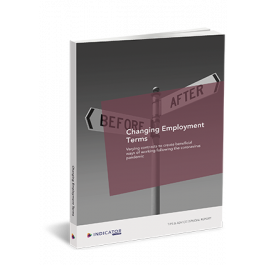Changing Employment Terms
Varying contracts to create beneficial ways of working following the coronavirus pandemic
A Tips & Advice Special Report about...
In a nutshell
This Special Report provides detailed guidance on the issues that you need to consider when changing an employee’s employment terms. As well as exploring how the law regulates the way in which you may vary employment terms, we look at the practicalities. It will ensure that you can make changes that are legally binding whilst minimising your exposure to risk.
In detail
The onset of the coronavirus pandemic forced most businesses to temporarily change and evolve their ways of working. As we slowly start to emerge from the restrictions and you begin to assess your specific long-term business needs in a post-pandemic world it may be that some of the temporary changes that had to be implemented on an emergency basis worked well for the business, with the result that you now want to make them permanent. Alternatively, there may be other changes to employment terms or the way in which employees work that you would like to make as part of a general business reorganisation. For example:
- Place of work - do you want some employees to continue to work from home on a permanent basis?
- Pay - do any temporary pay cuts need to be made permanent due to your current financial situation?
- Benefits - can you still afford to offer the same level of benefits, or are some of them no longer suitable or relevant given that employees are now permanently working from home or under a hybrid working arrangement?
- Working hours - do working hours or shift patterns need to reduce or change to give you more flexibility in the running of your business?
- Job duties - do some job duties need to change to reflect the fact that your business has moved on as a result of the pandemic?
This Special Report delivers all the essential advice that businesses need in 2022. It’s a practical guide for all employers to help ensure the future viability and success of your business in a post-pandemic world.
We've created this Tips & Advice Special Report especially for...
Business owners, personnel managers and HR officers that want to:
- Make changes to employment terms in a legally binding but risk-free way
You'll get the following free extras with this Tips & Advice Special Report...
An online service with ready-to-use documents
- To immediately apply our advice and solutions in practice
- That you can easily adapt to suit your own requirements
In this Tips & Advice Special Report you'll read about...
1. Identifying the contractual terms
1.1. How do we go about making a change to employment terms?
1.2. How do we know which terms are contractual and which are not?
1.3. How do we change a non-contractual provision?
1.4. What’s the next stage for changing a contractual term?
2. Changes authorised by the employment contract
2.1. In what circumstances might a change be authorised by the employment contract?
2.2. To what extent can we rely on specific flexibility clauses in the employment contract?
2.3. So are general flexibility clauses even harder to rely on?
2.4. Are there any other issues to consider when relying on a flexibility clause?
2.5. What are the risks if we rely on a flexibility clause that turns out to be invalid?
3. Changes not authorised by the employment contract
3.1. If we don’t have a suitable flexibility clause in the employment contract, what are our options for changing terms?
4. Changing employment terms with express consent
4.1. Is this option safe?
4.2. How do we go about obtaining an employee’s express consent?
4.3. Is an employee’s oral consent sufficient?
4.4. What follows if an employee gives their express consent?
4.5. What should we do if an employee hasn’t yet given their express consent?
4.6. Do we need to obtain an employee’s consent to beneficial contractual changes?
4.7. What if an employee still won’t agree to the contractual change?
4.8. How long is this process likely to take us?
4.9. Is there anything else to think about when seeking the employee’s express consent?
4.10. What if the employee still refuses to agree to the contractual change?
4.11. Can we ask employees to agree to permanent homeworking and a pay cut?
5. Implied consent and unilateral variation
5.1. How does an employee give their implied consent to a contractual change?
5.2. If we unilaterally impose a contractual change, what could the employee do in response?
5.3. What will an employee need to show to establish constructive dismissal?
5.4. What is a repudiatory breach of contract?
5.5. What is meant by the “last straw”?
5.6. How does an employee work “under protest”?
6. Dismissal and re-employment
6.1. Is dismissal and re-employment a safe option for changing employment terms?
6.2. How do we defend an unfair dismissal claim?
6.3. What is a fair dismissal procedure?
6.4. What notice period should we give?
6.5. If the employee accepts the offer of re-employment, how does this affect their continuity of employment?
7. Collective consultation on dismissal and
re-employment
7.1. Isn’t collective consultation only relevant in relation to large-scale redundancies?
7.2. Who must we collectively consult with?
7.3. What are the rules if we need to arrange for the election of employee representatives?
7.4. Are employee representatives entitled to time off work to carry out their duties?
7.5. What is the timetable for collective consultation?
7.6. What procedure do we need to follow to collectively consult?
7.7. When and how do we need to submit Form HR1?
7.8. What are the penalties for breaching collective consultation obligations?
8. The discrimination risk
8.1. What is the discrimination risk?
8.2. How does indirect discrimination occur?
9. Changes to the written statement of employment particulars
9.1. What terms are required to be included in a written statement of employment particulars?
9.2. What if the contractual change affects any of these mandatory statutory terms?
9.3. What’s the penalty for failing to issue a written statement of changes to employment particulars?
10. Documents
You can choose from the following options...
Paper
- The hard copy version
- Keep it on your desk or use it whenever you're offline
Digital
- The PDF-version
- Delivered to your inbox
Take a look at your options below.
Special subscribers' offer
£90.00
£70.00
Only if you already have a subscriptionStandard offer
£90.00
Special subscribers' offer
£90.00
£70.00
Only if you already have a subscriptionStandard offer
£90.00

Got a question? Call Customer Services
(01233) 653500


 (01233) 653500
(01233) 653500 







